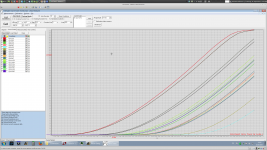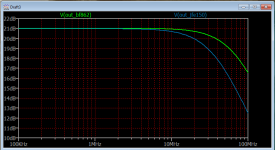Or the process ensures that they all perform well of course.
The JFET noise is a matter of device geometry (defining the flat noise) and process (defining mostly the corner frequency, also the x in 1/f^x), much simpler than in a bipolar device. There is very little room to wiggle in the variables, so the decision to avoid measuring the noise of individual parts is perfectly justified. In a mature manufacturing process, it would be very unlikely to get a part all in the datasheet guaranteed limits, but with an outstanding high noise.
Guaranteeing certain parameters "by design" is a very common practice in the semi industry today. Such parameters are usually mentioned in the data sheet, either explicitly "guaranteed by design", or by mentioning only typical values. Of course, for the right price and quantity, the noise could be 100% tested and guaranteed, but then you would not enjoy the prices
A manufacturer like TI or Toshiba has access to quite different resources as a Linear Systems.
As reflected by our own measurements of both 2Sk/2SJ & LSK/LSJ, including noise.
If people can quote 6 sigma values, they have their process under total control.
We shall continue to use 2SK/2SJ as long as we have stock.
I have about 100 pcs LSK/LSJ in my drawer, untouched since.
Cheers,
Patrick
As reflected by our own measurements of both 2Sk/2SJ & LSK/LSJ, including noise.
If people can quote 6 sigma values, they have their process under total control.
We shall continue to use 2SK/2SJ as long as we have stock.
I have about 100 pcs LSK/LSJ in my drawer, untouched since.
Cheers,
Patrick
I hope John can offer more insight into TI's Jfet process etc. It seems these are the first new discretes from TI in decades. And a quick check suggest almost the only discrete parts.
Linear Systems started as a used semi machinery company and they started making parts to demo the machines (or so I was told). They are not SOTA machines using 12" or larger wafers I believe.
TI on the other hand sold those machines off decades ago. (Possibly to Linear Systems?) So are they making discretes on systems designed for ultra high density parts? Or maybe, using otherwise discarded parts of the wafer to sneak some discretes in?
Linear Systems started as a used semi machinery company and they started making parts to demo the machines (or so I was told). They are not SOTA machines using 12" or larger wafers I believe.
TI on the other hand sold those machines off decades ago. (Possibly to Linear Systems?) So are they making discretes on systems designed for ultra high density parts? Or maybe, using otherwise discarded parts of the wafer to sneak some discretes in?
Even when Toshiba were manufacturing really interesting low noise jfets, John Curl used to laboriously measure the noise performance of hundreds of them and select those with the best performance for his low noise phono preamps.
So as has been said above, jfet noise performance is not a well controlled parameter, and selection bumps up the price. Interfet seem to do this with their INF3602 dual, and that is around $100 a pop. The downside is that Idss is ridiculously poorly controlled for those. And because they are large junction devices, capacitances are thought the roof. Swings and roundabouts.
So as has been said above, jfet noise performance is not a well controlled parameter, and selection bumps up the price. Interfet seem to do this with their INF3602 dual, and that is around $100 a pop. The downside is that Idss is ridiculously poorly controlled for those. And because they are large junction devices, capacitances are thought the roof. Swings and roundabouts.
Last edited:
Why do people ask for complementary quads ?
Take a look at section 3 & 4 here :
Distortion in JFET input stage circuits
See also :
F5 power amplifier
I agree with Demian.
If I can wish, I rather have separate NN & PP.
Not in SOIC 8, but a half SOIC14 with 7 legs on one side, like the 2SK389. And with thermal pad.
The clamping diodes is not really must-have in analog audio.
Patrick
I agree,
It's hard to handle in design when does not use VCH, VCL pins. Is it increase leakage currents in that case?
So as has been said above, jfet noise performance is not a well controlled parameter, and selection bumps up the price. Interfet seem to do this with their INF3602 dual, and that is around $100 a pop. The downside is that Idss is ridiculously poorly controlled for those. And because they are large junction devices, capacitances are thought the roof. Swings and roundabouts.
IF3602 (IF3601 for singles)
They have a revised data sheet, still optimistic, but at least closer to reality (Mouser). Completely pointless.
I suppose they do select, and you get the outliers.
8 Pairs, Results of a lot of money, badly spent:
Attachments
Last edited:
For the sake of completeness ('scuse me if I am way behind in this thread):
2SK238 FM = 111 MHz
2SK508 FM = 862 MHz
These parts were copiously used in Sony shortwave receivers, for RF preamps (followers) and mixers in particular, 2SK152 in the '80s and 2SK508 since about 1989. Suffice it to say, recommending a part to replace the long-EOL'd 2SK508 if blown has not exactly been easy, with BF862, 2SK1070 and 2SK3557 still getting the closest. Can't beat '90s Japan for analog discretes, I guess.
In the ever dwindling field of specialty JFETs, any new entry is highly welcome.
2SK152 FM = 597 MHzFigure of merit(FM)=gm@Vgs=0V/(2*PI*Ciss@Vgs=0V) [MHz]
Some numbers:
Toshiba 2SK170 FM=112MHz
Toshiba 2SK209 FM= 184MHz
TI JFE150 FM=361MHz
Interfet IF3601 FM=398MHz (overestimated, Ciss is not spec'd at Vgs=0V)
Sanyo/Onsemi 2SK3557 FM=558MHz
NXP BF862 FM=765MHz
Sanyo/Onsemi 2SK932 FM=796MHz
2SK238 FM = 111 MHz
2SK508 FM = 862 MHz
These parts were copiously used in Sony shortwave receivers, for RF preamps (followers) and mixers in particular, 2SK152 in the '80s and 2SK508 since about 1989. Suffice it to say, recommending a part to replace the long-EOL'd 2SK508 if blown has not exactly been easy, with BF862, 2SK1070 and 2SK3557 still getting the closest. Can't beat '90s Japan for analog discretes, I guess.
In the ever dwindling field of specialty JFETs, any new entry is highly welcome.
I hope John can offer more insight into TI's Jfet process etc. It seems these are the first new discretes from TI in decades. And a quick check suggest almost the only discrete parts.
Linear Systems started as a used semi machinery company and they started making parts to demo the machines (or so I was told). They are not SOTA machines using 12" or larger wafers I believe.
TI on the other hand sold those machines off decades ago. (Possibly to Linear Systems?) So are they making discretes on systems designed for ultra high density parts? Or maybe, using otherwise discarded parts of the wafer to sneak some discretes in?
There's not really any sort of technology barrier to us making discretes, rather the question for all semiconductor companies is what is the profit generated per wafer? In many cases the discrete business has been "commoditized" to the point where the profit per wafer is extremely low, and it makes more sense to build other products using that capacity in your factory. High performance JFETs just happen to be one area where two well-matched transistors actually garner a higher price than with the rest of the op amp we usually put around them...
The process technology used for the JFE150/2140 is the same bipolar process we use for op amps such as the OPAx140/164x/827/828/145 among many others.
There's >2000 currently in stock at ti.com: https://www.ti.com/store/ti/en/p/product/?p=JFE2140DR
What is the max useable frequency for the JFE150?
Mostly it's dependant of source resistance aka ability to charge/discharge parasitic capacitances.
Sure, the JFE150 has higher Cgs and Cgd and following a worse frequency response.
The gm/Ciss FOM for the JFE150 is also inferior to the BF862, making it less recommended for high source impedances.
None of these concern audio, or any other low frequency applications, though.
The gm/Ciss FOM for the JFE150 is also inferior to the BF862, making it less recommended for high source impedances.
None of these concern audio, or any other low frequency applications, though.
- Home
- Vendor's Bazaar
- Ultra Low Noise JFETs from Texas Instruments

